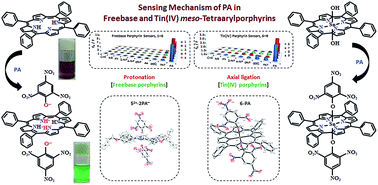Protonation and axial ligation intervened fluorescence turn-off sensing of picric acid in freebase and tin(iv) porphyrins†
Abstract
Freebase and tin(IV)-porphyrins are examined for the selective detection of picric acid and their affinity is revealed by spectroscopic titrations and X-ray structures. The sensing is mediated through protonation and axial ligation in 1–5 and 6–9 respectively. Fluorescent lifetime studies show that the quenching is dynamic in the freebase and static in tin(IV)-porphyrins.


 Please wait while we load your content...
Please wait while we load your content...